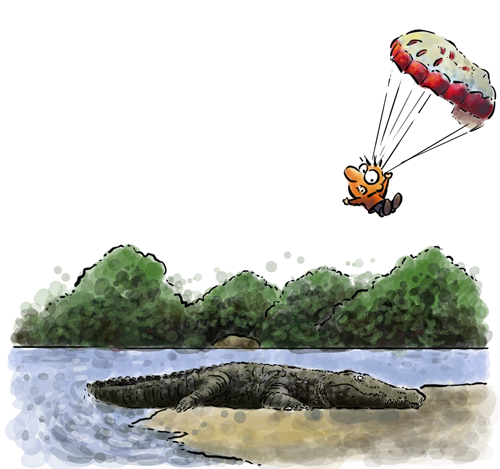Anyone can tell a story, but how do you create a “driveway moment” story?
So what's a “driveway moment” story, and how is it different from a regular story?
Imagine you've just driven back from the supermarket with your groceries—and yes, a tub of ice-cream. You park in your driveway, but you don't open the car door. You're glued to the seat of your car.
The reason you can't budge is because you're locked into a story that's unfolding on the car radio. And you stay in your car to hear the story to the end.
Then it ends, and you realise that you've completely forgotten about the ice-cream, which has been sitting there melting.
When you have a driveway moment, you often don't realise you're sitting in your driveway. You drive home on automatic pilot, engrossed in the story. And either you're sort of unaware that you're sitting there—or you're aware of how silly it is to be sitting there in a parked car but can't pull yourself away.
Why aren't the stories you write, this gripping?
When you write a story, you often ramble on because you're not sure when to stop. You're not sure if the story is relatable, or if it's even mildly interesting to the reader. Is it just boring or is it wonderful? Using storytelling to make a point turns out to be a lot harder than you ever thought it would be.
And there are more problems: You end up telling the same story over and over again, and you struggle to connect them
Let's say you're an expert at some skill. Your articles, books, podcasts, presentations—they're all about one topic. And yet, you know you need a lot more than a single story to get the message across.
So how do you create dozens of stories to represent a single topic?
And even if you do come up with a story that really seems to work, there's the struggle of connecting it to the rest of the information. Is the story really bringing out your point, or does it seem like it just got stuck in the middle of the article? And wouldn't it be great if every one of those stories was also a driveway moment story?
Presenting: The Driveway Moment Storytelling

The biggest reason we end up in a storytelling swamp is because storytelling isn't one phase, but three distinct phases. You have to find a story, craft it so it shines and then connect it to your content. If we miss out on any of those three stages, our hard work and effort quickly ends up in swamp-land.
In this book we tackle the core of storytelling
You'll learn how to find great stories relatively easily. Then you move to crafting the story into something magical. And finally, how to connect the stories to your content in a seamless manner.
You learn why so many stories seem to start out with a lot of promise, but then go nowhere, simply because they don't have the following elements:
-
-
-
- Contrast
- Space
- Sequence
-
-
And here are the three elements in detail
Element 1: Contrast
Imagine you had never seen a heart monitor before. You would have a rough idea of how a healthy heart should display on the screen with a gentle “thumpity thump”. But when someone sees a heart monitor for the first time, it takes them by surprise. The heart beats seem have really big spikes.
Spikes are engineered to create driveway moments.
Spikes create interest when the audience’s attention is flagging. But too many spikes can cause the audience to feel agitated. In order to create just the right number and size of spikes in your stories you’ll learn how to use the power of disconnectors, connectors and drama. And to do it all without slipping into a ramble.
Element 2: Space
What is music composed of? The immediate answer is: A flurry of notes strung together. Yet, think about it for a second. It’s really the space between the notes that makes the music. If all the notes followed in quick succession, you don’t get music—you get noise.
Stories need space.
The space is what creates moments of anticipation. The reader or listener feel these moments of quiet, like you feel the calm before the storm.
Whether you’re writing a book, creating a podcast or making a presentation, learning to work with space is critical. Brilliant storytellers know how and when to use “space” to create intense drama.
Element 3: Sequence
It’s easy to believe that storytelling is a series of events neatly tied up together. In reality, the essence of every story boils down to ONE word. When you boil down your story to a single word, it’s easier to build a precise story sequence.
Your story never goes off track—and even if it does—the ONE word pulls it right back.
Have you ever watched someone squint at a page as they tried to read without their reading glasses? They struggle to read, turning the page this way and that way to try to see more clearly. When you write a story using ONE word, it’s like you gave every reader the perfect glasses.
Every story you write is perfectly clear.
So what should you expect as a result of following the story telling process?
1) Different angles: You'll be able to explain a single concept by creating dozens of different stories.
2) No ramble: You'll learn to craft stories that are crisp and fat-free, with specific steps.
3) Professional: Your stories won’t make you look unprofessional—even if you choose to tell personal stories.
4) Get Unstuck Quickly: You'll know exactly where to get inspiration for a story when you're stuck (within five minutes or less).
5) Judgment: You'll be able to trust your judgment and to know whether the story is a good one or not.

Is your story skating on thin ice? Is it rambling? Will you be able to cover different angles? Will your story look professional? All these thoughts and doubts can seriously derail your project and confidence. Learn precise structure to build a story step by step—and then test if the story works or not.
What this system is NOT:
1) This isn't a writing course. You won't learn how to write. We have other courses for that, including the Article Writing Course. This course is about the structure of stories and how to put that structure together to craft a great story.
2) It's not a sales course. While you'll learn how stories are used in sales letters or even live sales situations, this is not about how to sell.
And here is what you'll learn…
You will learn:
- How to create memorable stories. Learn how to use the 90% principle to tell stories that clients never forget, even years later.
- How to put together a story without hair-pulling and head-banging. You'll learn a simple, intuitive system that will enable you to produce stories consistently and without the frustration that often arises out of a creative process.
- Creating boring stories enables us to examine what makes them boring. In the future, an alarm will go off in your head when you create a boring story. Best of all, you'll know how to fix the story.
- Well-told stories create a bond with the audience because stories aren't boastful, they're vulnerable. And it's important to be able to tell these stories without sounding unprofessional.
- How to audit your story: When do you add more information, and what do you chop?
- The intense power of “disconnectors” and “reconnectors”. How they form the thread of suspense and drama.
- The power of location and why most story tellers miss out on a simple tool that can enhance their stories considerably.
So what's the biggest difference between this story telling book and any other?
Most storytelling products are about taking the story from one point to the next. They tell you that it’s all about sequence, the inciting incident and other such story elements. Most of the books and course seem to focus on the storytelling skill alone, forgetting that we have there's a lot more at stake. We have to go beyond the driveway moment. We have to then connect our stories back to our information in a meaningful way.
For us to successfully use a story in business, we have to cover all three elements:
- Finding the story
- Crafting the story
- Connecting the story to our content.
All three of these skills need to be worked on, to be workable so we can use it in our articles, webinars, presentations, podcasts and books.

Storytelling focuses a lot on how to craft the story itself, but leave out how to find the story or then how to reconnect it back to our article. The difference between this storytelling product and any other, is that all three stages are covered.
So yes, we'll see you at the StoryTelling Workshop
You may want to read the Frequently Asked Questions below as well, as they'll answer most of the um, frequently asked questions. Feel free to email me at sean@psychotactics.com, if you have any more questions (no question is too silly, too big or too little).
Before you read further bookmark this page.
Frequently Asked Questions: (This workshop is closed)
Where is the workshop being held?
The workshop will be held in two locations.
Nashville, Tennessee, USA
Amsterdam, The Netherlands
What are the dates and timing for the workshop?
This is a 3-day workshop.
Nashville: 2, 3 and 4 December 2015
Amsterdam: 15, 16 and 17 December 2015
Time: The workshop will start at 8:32 am each day and wrap up at 4:15 pm. No midnight sessions.
What is the price? And is there an installment plan?
Please look below for the price. You also get the option of a three-part installment payment.
When will the prices increase? (Prices are in Euros or Dollars)
Price after 15 November—$1200
Last Minute Price—$1800 (only if there are seats available)
Is there a Home Study?
For now there is no home study. If we decide to do a home study we will announce it via the newsletter.
How do I sign up right away?
You can sign up below. And no, there are no discounts even if you sign up more than one person. The prices are overly reasonable when considered with workshops of this calibre.
Are there any conditions?
There's an important condition. Come join us, but be aware that you need to have read The Brain Audit in advance. Yes, it's a barrier. But it ensures that we have clients that are truly interested in learning and improving their business. You can buy and read The Brain Audit at any point before the event, but we will not accept you if you have not read The Brain Audit. There are no exceptions to this rule.
What happens if I can't attend for some reason?
Once payment is made, there will be NO refunds. You are welcome to send a substitute in your place.
About meals
At the workshop you will be provided with coffee and tea. Meals just put up the price of the event, and most people have their own diets anyway. We will choose a venue where there are stores and restaurants nearby and meals are easy to get, and far more economical than if we added meals to the workshop price.
What are the durations of the sessions?
We start at 8:32 am (yes, you noticed the odd time, right?) We break at 10:30 am, 12:30 pm and 2:30 pm. By 4:15 pm, we're done for the day. There's no mindless, droning workshop that goes on and on into the evening.
What is the dress code for the workshop?
Wear comfortable clothing. The dress code is casual. But remember to bring a sweater with you as conference rooms tend to get hot and cold. We will remind you about the sweater many, many times over. Sweater or some jacket is absolutely needed, no matter how warm the weather.
What material do I bring with me & do I need to prepare before?
It is not necessary to bring any material with you. You can bring along any material (related to story telling) that you need to ask questions about. I'll be happy to help you during the breaks or at the end of the day.
Do you have any further questions? Anything we've left out?
Email us (either Renuka or me) at sean@psychotactics.com or renuka@psychotactics.com. You should hear from us in 24-48 hours. If not, contact us at:
Facebook: https://www.facebook.com/sean.dsouza (yes, the Facebook link is quite reliable).
Also special premium bonuses
# 1 Big Bonus: Sean's Critique Worth $250
After you complete the workshop, you'll still need the reassurance that you're writing great stories and connecting well. This bonus entitles you to send in your story and it will be audited.
Note: Your piece needs to be fewer than 800 words and will be audited in late Jan 2016 (as we close for the Christmas season). This gives you time to work with the concepts in December and send in your piece in Jan 2016.
# 2 Big Bonus: My Story Resources + Storage System (worth $119)
You've read The Brain Audit haven't you? It's filled with stories and examples. Listen to the podcasts or read the transcripts—again stories. Do a course or a workshop and the slides and notes are filled with stories and examples. Where is this well spring of stories? Where do I get an endless amount of stories from, and more importantly how do I find them just when I need them?
That's just one part of the resources. The second part is finding sources of great stories. You become a storyteller using two methods. The first method is learning how to tell stories. The second method is listening to, or reading stories, so that your skill keeps getting better. What are the sources of my stories?
YES  I have read the conditions and am ready to sign-up for the Live Workshop—I don't want to miss out! (This workshop is closed)
I have read the conditions and am ready to sign-up for the Live Workshop—I don't want to miss out! (This workshop is closed)
3-Day Live Workshop |
Regular
|
Premium
|
| 3-Days live Workshop with Sean D'Souza |
|
|
|
Premium Bonuses
|
||
| Sean's Critique Worth $250(This bonus entitles you to send in your story and it will be audited) |
–
|
|
| Sean's Story Resources + Storage System(worth $119) |
–
|
|
| Price ( US$ or Euros) | ||
| Full Payment |
3400
|
3500
|
| 3 Installment Payments (Billed every month for 3 months) |
1133 x 3
|
1200 x 3
|
| Important 1) All Payments are in US $ or Euros and will be billed once you click the payment button. 2) Your seat will be confirmed – once your payment clears. 3) There will be NO refunds. You are welcome to send a substitute in your place. |
||
Important
1) If by any chance, you are not able to validate your card please don't tear your hair out in frustration. You can email Renuka and she will send you an ALTERNATIVE LINK to process your credit card. All payment systems are secure.
2) If you have any questions that have been unanswered, please email me directly and let me know how I can help. I'd be interested in getting your feedback. The feedback that you give me, is strictly confidential. Don't forget to include your telephone number and a time to call you.
Important Usage: What will happen once you click the button.
1) You will be taken to a page where you can fill in your credit card or cheque details.
2) Once you pay you will be taken to a form.
3) Once you fill the form, you will receive an email with more details.
Sean D'Souza- Brain Auditor 🙂
P.S. Put your trust in education with the right source, and that trust will not be violated. You'll get the best possible education and advice. And just for good measure, there are installments, so it can be more affordable to you. It's good advice, so take it.
Goods and services provided by
Psychotactics (Po Box 36461,Auckland, New Zealand).
2CheckOut.com Inc. (Ohio, USA) is an authorized retailer for goods and services provided by Psychotactics.

